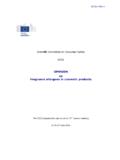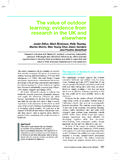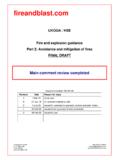Transcription of Modelling of liquid hydrogen spills - Health and …
1 Health and safety Executive Modelling of liquid hydrogen spills Prepared by the Health and safety Laboratory for the Health and safety Executive 2014. RR985. Research Report Health and safety Executive Modelling of liquid hydrogen spills R Batt Health and safety Laboratory Harpur Hill Buxton Derbyshire SK17 9JN. In the long term the key to the development of a hydrogen economy is a full infrastructure to support it, which includes means for the delivery and storage of hydrogen at the point of use, eg at hydrogen refuelling stations for vehicles. As an interim measure to allow the development of refuelling stations and rapid implementation of hydrogen distribution to them, liquid hydrogen is considered the most efficient and cost effective means for transport and storage.
2 The Health and safety Executive (HSE) have commissioned the Health and safety Laboratory (HSL) to identify and address issues relating to bulk liquid hydrogen transport and storage and update/develop guidance for such facilities. The second phase of the project involved experiments on unignited (HSE RR986) and ignited releases of liquid hydrogen (HSE RR987) and computational Modelling of the unignited releases. This position paper assesses the ability of the cryogenic liquid spill models available to the HSE to model spills of liquid hydrogen by using the new experimental data obtained from the experimental testing at HSL.
3 A brief literature review on Modelling liquid hydrogen pool spread was undertaken and Modelling with GASP. (Gas Accumulation over Spreading Pools) to compare results with the experimental measurement data. Recommendations are made on improvements to currently available models and also recommendations for further model validation data. This report and the work it describes were funded by the Health and safety Executive. Its contents, including any opinions and/or conclusions expressed, are those of the authors alone and do not necessarily reflect HSE policy. HSE Books Crown copyright 2014. First published 2014.
4 You may reuse this information (not including logos) free of charge in any format or medium, under the terms of the Open Government Licence. To view the licence visit , write to the Information Policy Team, The National Archives, Kew, London TW9 4DU, or email Some images and illustrations may not be owned by the Crown so cannot be reproduced without permission of the copyright owner. Enquiries should be sent to ii CONTENTS. 1 INTRODUCTION .. 1. 1. Approach .. 1. 2 LITERATURE REVIEW .. 2. Models .. 2. liquid hydrogen spill 3. Physical processes at the source .. 4. 3 TEST 6 MEASUREMENT ANALYSIS .. 7.
5 4 GASP Modelling 12. Model input and output .. 12. Vaporisation rate validation .. 13. Experimental test case HSL Test 15. 5 RESULTS AND DISCUSSION .. 18. Vaporisation rate validation .. 18. Experimental test case HSL Test 21. 6 CONCLUSIONS .. 26. 7 RECOMMENDATIONS .. 28. 8 REFERENCES .. 29. iii iv EXECUTIVE SUMMARY. Objectives The objective of this work was to assess the ability of the cryogenic liquid spill models available to the Health and safety Executive (HSE) to model spills of liquid hydrogen by using the new experimental data of Royle and Willoughby (2012). In order to meet this objective three main tasks were undertaken: A brief literature review on Modelling liquid hydrogen pool spreading.
6 Carry out Modelling with GASP (Gas Accumulation over Spreading Pools) and compare results with the experimental measurement data taking into account issues specific to liquid hydrogen , including sensitivity to specific model parameters or Modelling assumptions. Provide recommendations on improvements that could be made to currently available models and also recommendations for further model validation data. Main Findings The literature review showed that most previous Modelling of liquid hydrogen spills had been carried out using integral models such as GASP, which is the model currently used by HSE for Modelling pool spreading.
7 There has been relatively little three dimensional Computational Fluid Dynamics (CFD) Modelling carried out to date, the majority of which has used a simpler model to provide source information and CFD to model the subsequent gas dispersion. However, there have been recent developments in CFD Modelling of the pool spreading itself, along with other source options. An analysis was carried out of the measurements from the ground level probes used in Test 6 of the experiments undertaken at HSL (Royle and Willoughby, 2012). This analysis showed evidence of a gravity current of cold air that propagated ahead of the spreading pool of liquid hydrogen .
8 The radius of the spreading pool was extracted from the Test 6 experimental data for comparison with the GASP model. The setup configuration of Test 6 means it is the most suitable of the HSL experimental datasets for validation of the model. The extracted data showed a pool increasing rapidly to a fairly constant radius, expanding further and then retracting. Once the release stopped the pool showed potential preferential evaporation from the centre. Two validation exercises were carried out using GASP. A preliminary validation was performed of the vaporisation rates for contained, non-spreading, liquid oxygen and liquid hydrogen on a concrete substrate using published experimental data.
9 However, uncertainty in the thermal properties of the concrete in the experiment made the validation exercise difficult. Some differences in the experimental results and model predictions were observed, one possible explanation being film boiling occurred in the hydrogen tests, which GASP does not account for. It was also shown that GASP can produce spurious results if the wind speed is set to zero, although in cases where boiling dominates the liquid vaporisation, as in the cases considered here, reasonable results can be obtain by setting a low wind speed of, say, ms-1. The second validation exercise was performed against the HSL Test 6 results.
10 The model predictions of the time to vaporisation after the release had stopped were found to be sensitive to the so-called puddle depth'. Overall, GASP performed better than expected and provided predictions of the pool radius that were in reasonable agreement with the experimental data despite the model not being able to account for the solid formation seen in the experiments. The hydrogen vaporisation rate was not measured in the experiments so validation of this parameter v was not possible, however, the predicted mean vaporisation rate was found to be equal to the discharge rate and was not sensitive to the Modelling parameters.














